Log in or create new account to save this product to your wishlist.
Fertilising plants: a guide for gardeners
Providing the right level of nutrients for your garden plants is a bit of an art form. Find out how and when to feed your garden plants for the best results.
Latest articles
7 MIN 22 Jul How to keep your lawn in shape this summer 9 MIN 15 Jul Watering Your Garden: 10 Top Tips! 11 MIN 15 Jul Is Your Grass Type Right for your Garden? 11 MIN 10 Sep Create Your Low-Maintenance Garden – Tips and Ideas 11 MIN 08 Sep The Ultimate Guide to Choosing the Perfect Hedges for Your Garden 12 MIN 30 Aug The Top 20 Evergreen Climbers to Transform Your GardenGardening is a wonderful activity that positively impacts your physical and mental health while beautifying your outdoor living space. It’s a great way to get in touch with nature — you can even grow your own food. But for excellent results, you need to feed your soil.
- Why plant fertilising is essential for healthy growth
- NPK — The 3 Essential Active Ingredients of fertiliser
- Understanding plant fertilisers
- Organic vs inorganic fertilisers for plants
- Avoid universal fertilisers when planting
- When to Fertilise your plants — An Annual Plan
- Choose the right time of day for fertilising
- Don’t over-fertilise!
- Identify plant needs with the nitrate test
- Use the eye test for plant fertilising
- Methods of fertilising your plants
- Fertilising your plants — a step-by-step guide
- FAQs
- Why fertilise your plants?
Because what you produce is only ever as good as the earth you grow it in, and if you’ve let your soil go to rack and ruin, expect poor results.
This article is all about fertilising plants so that they thrive. We’ll cover why it’s necessary, what the information on the packet means, and how and when to apply the correct fertiliser for the best results.
And just for balance, we’ll also look at the common mistakes people make when fertilising their gardens.
Ready? Let’s get started.
Why plant fertilising is essential for healthy growth
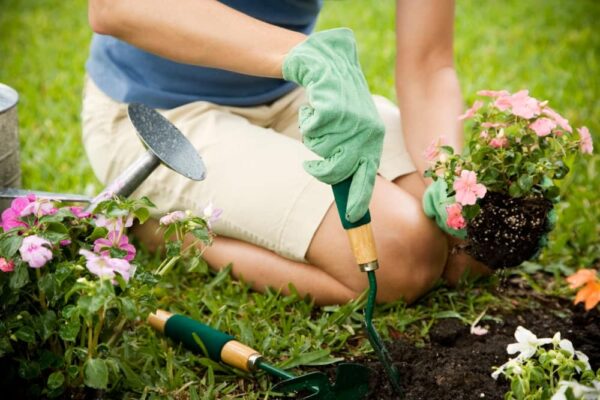
Plants need essential nutrients to help them thrive — drawing nourishment through their roots from the earth. And while these nutrients are naturally occurring, heavily-used flowerbeds, turf, and veg patches become depleted over time.
And that’s where fertilising comes in to save the day. Fertilisers are an excellent way to re-enrich the soil, replacing the nourishing compounds that your plants need.
Additionally, fertilising improves the soil structure to facilitate better water and oxygen absorption for your plants.
NPK — The 3 Essential Active Ingredients of fertiliser
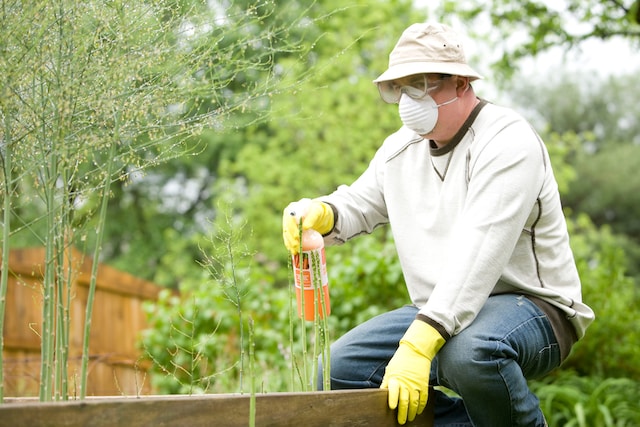
Not all fertilisers are the same, so there are very few one-size-fits-all approaches to feeding your soil. And while some products claim to be All-Purpose fertilisers, you’ll only get optimal results if you address the needs of the specific plants you’re aiming to feed.
The most essential nutrients contained in most fertilisers are:
- Nitrogen (N)
- Phosphorus (P)
- Potassium (K)
And while other ingredients, such as lime, magnesium oxide, and sulfur, are contained in many fertilisers, it’s the NPK content that you should really look out for.
Because:
- Nitrogen (N) is an essential component of chlorophyll and promotes foliage growth
- Phosphorus (P) supports root growth and flowering
- Potassium (K) contributes to general plant health and disease resistance
So, look at your fertiliser packet: it will display an NPK ratio (or it might just say something like 15-9-12, which would be 15% nitrogen, 9% phosphorus, and 12% potassium).
So, a nitrogen-rich fertiliser is ideal for a growth boost in the spring. However, use a high-potassium feed if you’re preparing your plants for wintering.
Lawn doctor Louis says:
Read my detailed NPK fertiliser article to master the art of appropriate feeding.
Understanding plant fertilisers
As well as understanding the NPK composition of your chosen fertiliser, there are some other points you’ll need to consider.
Firstly, consider the plant species you’re feeding because each plant requires specific active ingredients to thrive.
That’s not to say you’ll need a different fertiliser for every plant in the garden. An All-Purpose Fertiliser will suffice for most of the flowering plants in your garden. Still, you’ll need specialist fertilisers for ericaceous (acid-loving) plants, such as rhododendrons, or a high magnesium/potassium-rich formula for roses.
Additionally, consider whether your fertiliser is organic or inorganic.
Organic vs inorganic fertilisers for plants
There are two principal approaches to feeding your plants:
- Organic — using a plant/mineral/animal-based composition
- Inorganic — using a chemical-based composition
Organic fertilisers
Organic fertilisers are usually slow-release formulas derived from plant, animal, and mineral sources. They improve soil structure and encourage microbial activity within the earth.
Examples of organic fertilisers are:
- Compost — homemade or shop-bought
- Well-rotted manure — never use raw manure because the ammonia content is too high and will burn your plants
- Algae
- Bone meal, such as Fish, Blood & Bone
Inorganic fertilisers
Inorganic fertilisers are factory-produced chemical compounds offering a quick nutrient boost — especially effective after planting or transferring.
These fertilisers are more highly-concentrated than organic fertilisers and can be used to increase soil nutrient levels quickly.
Examples of inorganic fertilisers are:
- Synthetic fertilisers
- Chemical fertilisers
Lawn doctor Louis says:
I often advise against artificial fertilisers wherever possible. They have an immediate effect, but it doesn’t last for long. Better to go for slow-release formulas, which are better for the environment.
Avoid universal fertilisers when planting
Choose a fertiliser specific to the plant you’re growing, transferring, or replanting.
As a rule of thumb:
- Vegetables need a high-nitrogen fertiliser to encourage leaf growth
- Flowers need phosphorus-rich feed to encourage root growth and flowering
- Trees and shrubs require high levels of potassium to promote plant health and disease resistance.
When to Fertilise your plants — An Annual Plan
Several variables dictate how you approach your annual fertilising plan.
Before diving straight in, consider:
- Is your plant currently under-fertilised or well-fed?
- Are you preparing for a specific season?
- Are you helping a plant recover from disease?
Fertilising at the right time of year
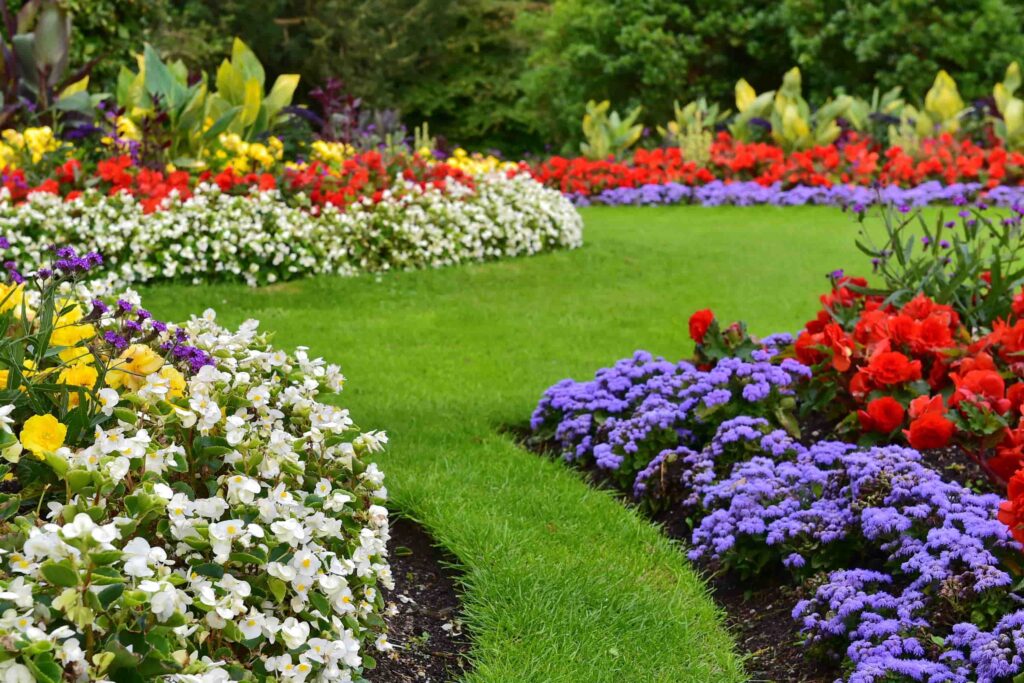
Once you’ve found the right fertiliser for your plants, the next question is how often to apply feed. Bear in mind that, just like us, plants go through different growing phases, so choose the right fertiliser appropriate to the season.
The three main feeding windows are:
- Early spring and simmer
- Late summer/early autumn
- Late autumn
In general, plants need a specific concentration of active ingredients to survive each season. And remember, plants react to weather conditions, so might not need feeding as much when it’s cold.
However, this all sounds super-complicated, doesn’t it? Don’t tear your hair out — here’s a seasonal overview to make things a little simpler:
Spring
In the spring, your plants wake up from their winter dormancy and need an extra dose of potassium. This strengthens their disease resistance and prepares the plant for the coming season.
Plants also enjoy a good portion of phosphorus and nitrogen to strengthen root growth and encourage leaf growth and flowering. It’s good to use a fertiliser with added magnesium oxide in spring, which will add a beautiful green to foliage.
Apply iron sulphate to your lawn to strengthen your turf, kill off the winter moss, and prepare your grass for scarification.
Summer
Prepare your plants for the (hopefully) hot, dry days ahead at the end of spring/early summer with a slow-release fertiliser enriched with nitrogen and potassium.
Late summer
After a (hopefully) hot, dry summer, your plants need a little recovery time. So, support them with a potassium-rich fertiliser enriched with magnesium oxide. This stimulates cell renewal, which helps your plants fight off lurking autumnal diseases.
Early autumn
A potassium-rich fertiliser during the early days of autumn will prepare your plants for the milder temperatures and more rain. Use a potassium-rich fertiliser to give your plants a good health boost.
Late autumn
This is the time to prepare your plants for the winter. Lime is perfect for this time of year because it helps reduce soil acidity, discouraging weed growth. It also makes it easier for your plants to absorb more nutrients in the spring.
Winter
It’s too cold to fertilise because most plant roots become inactive and don’t need to absorb nutrients.
So, put your feet up!
Lawn doctor Louis says:
Always follow the instructions on the packaging — each fertiliser is different, so make sure you know what you’re applying to your soil. Otherwise, you could over- or under-fertilise.
Choose the right time of day for fertilising
Early morning or evening are the best times for fertilising your plants if you’re using a granulated or slow-release feed because you’ll need to water immediately afterwards to activate the feed.
If you water during or just before intense sun, your plant’s foliage can burn, and the water required to activate the fertiliser evaporates too quickly.
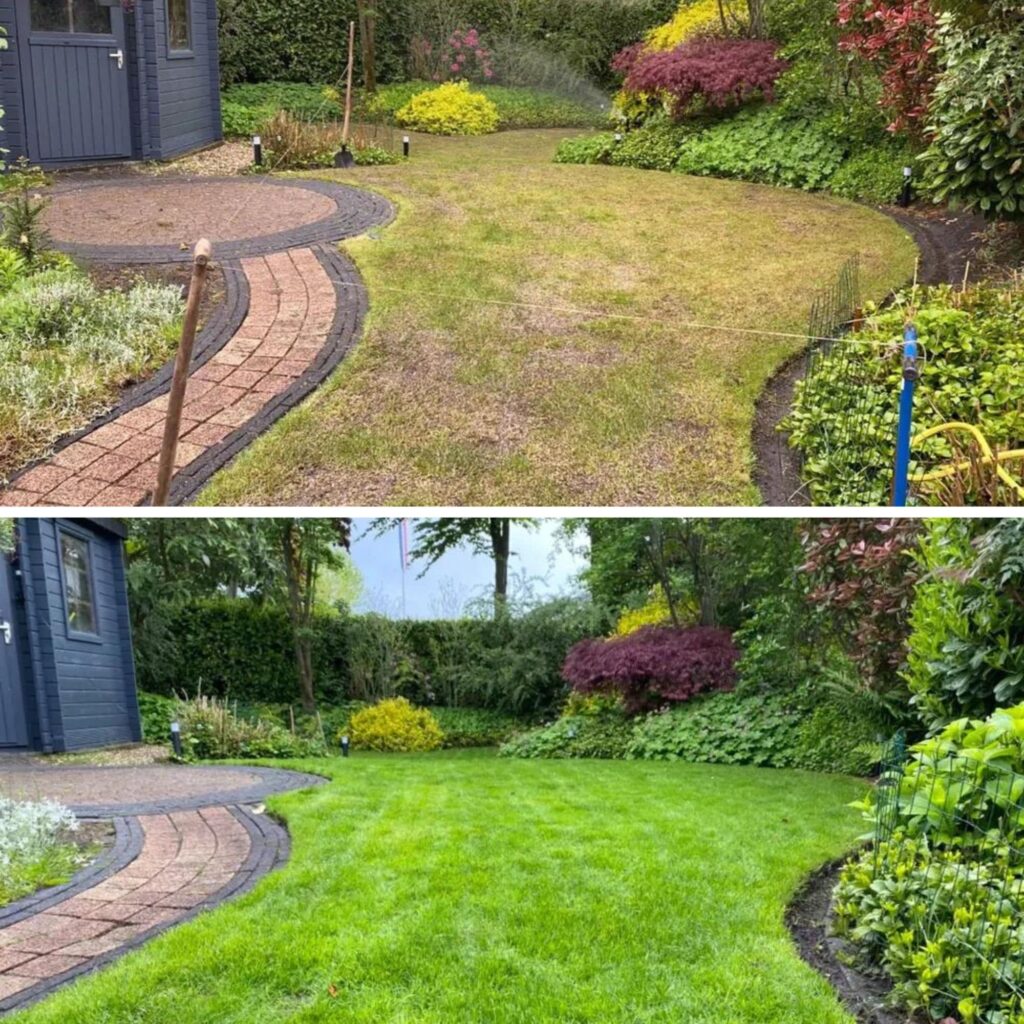
Don’t over-fertilise!
Over-fertilisation can lead to root- and foliage burn, nutrient imbalance, and poor plant growth. So, always check the instructions of your specific fertiliser to understand how regularly you should apply your feed.
Bear in mind that the nutrient demands of each plant species could vary, so research your garden plants before you buy your fertiliser.
Lawn doctor Louis says:
I group my plants by genus — this makes fertilising much more straightforward and effective.
Identify plant needs with the nitrate test
Conducting a nitrate test is the fastest way to determine whether your plants need feeding. So, take a soil sample and use a nitrate test strip to determine the nitrogen content of your soil. If it’s too low, it’s time to fertilise.
If the nitrogen levels are still within the target range, there’s no need to fertilise.
However:
If the leaves are well-above target levels, dilute the soil by adding additional soil. Alternatively, you can flush out the excess nutrients with increased watering. But this isn’t without its risks: overwatering can lead to compacted soil and root rot.
Use the eye test for plant fertilising
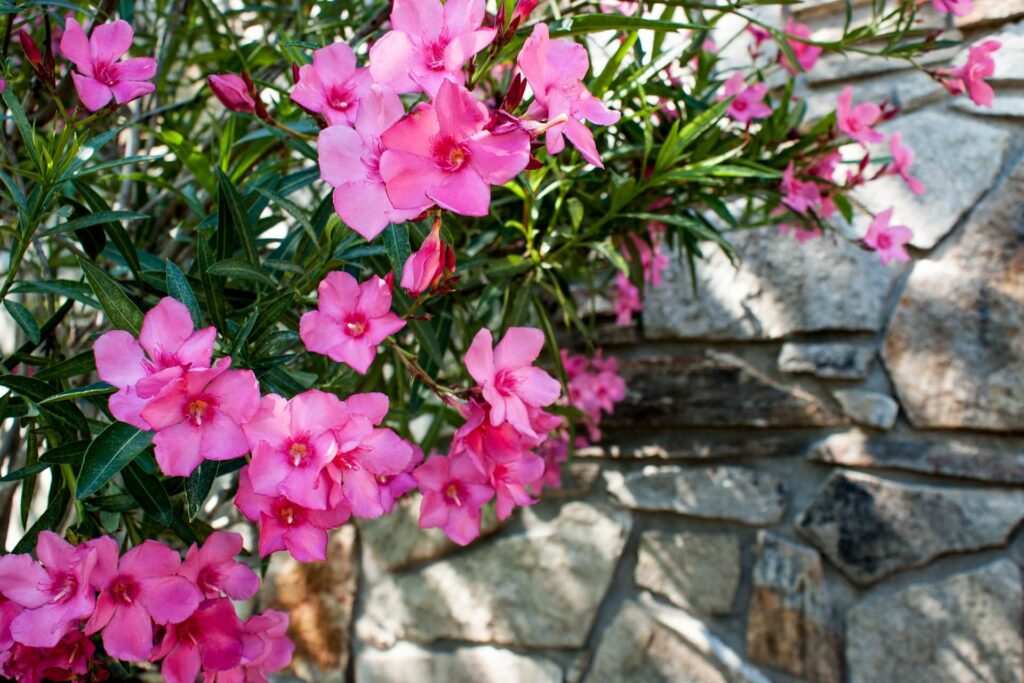
An experienced eye can tell just by looking at a plant whether it needs feeding.
Look out for:
- Limp, yellowish leaves
- Leaf discolouration
- Discoloured spots on leaves or stem
When transplanting plants into your flowerbeds, check the roots for rot. If you find unhealthy-looking roots, prune off the rotten sections before planting.
Methods of fertilising your plants
There are three principal forms of shop-bought fertiliser:
- Liquid fertiliser
- Granular fertiliser
- Powder fertiliser
Personally, I prefer granular fertilisers because they tend to offer slow-release feeding and are easier to target around the plant stem. And they don’t get so easily blown away in the wind.
This is the best way to apply the various fertilisers:
Liquid fertiliser
Spread liquid fertiliser with a pressure sprayer, such as MOOWY’s high-quality sprayers, with volumes of 4/7/10 litres.
Granular fertiliser
Distribute granular fertiliser by hand.
If you’re fertilising large areas, you might opt for a hand spreader, ensuring even nutrient distribution.
Powder fertiliser
Apply powder fertiliser either by hand (make sure you wear gloves!). Alternatively, you could use a hand shovel.
Avoid applying powder fertilising when it’s windy — the powder will blow away in the wind, and you could end up fertilising the wrong plants or even poisoning fish ponds, etc.
Lawn doctor Louis says:
Always protect your eyes, hands, mouth, and nose when applying fertiliser because many commercially-available feeds are toxic. Use MOOWY’s Lawn Spray safety kit for extra safety. Perfect for lawns and flowerbeds.
Fertilising your plants — a step-by-step guide
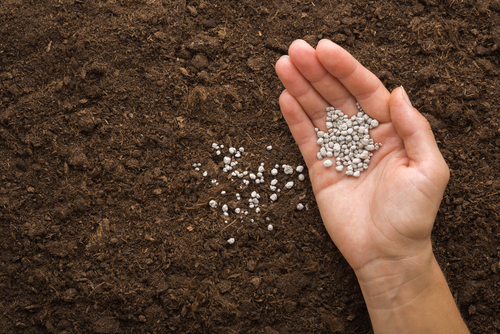
Your fertiliser needs to get down into the roots — otherwise, it won’t be effective.
So, ensure the soil is well-aerated, loose, and crumbly, like this:
- Clear weeds, stones, twigs, and other debris from the soil surface
- Loosen the surface soil with a rake or hand fork.
- For beds: work a small amount of organic matter, such as well-rotted compost, into the soil. This helps improve the soil structure and improves the nutrient potential. For lawns: you could use a scarifying rake, which will also remove the thatch layer that could suffocate the roots.
- Apply your fertiliser of choice.
- Water well. This helps remove any fertiliser that may have landed on leaves, preventing leaf burn. It also helps activate the fertiliser.
- Wait. You should see results within a few days.
FAQs
It depends on the season and the needs of the plant. Plants should be fertilised at least four times a year: in spring, spring, autumn and for wintering. But fertiliser is also necessary after a disease attack.
Carry out a nitrate test to determine the nutrient content of the soil. If it shows too little nitrogen, it’s time to fertilise – ideally in the early morning or evening. This prevents scorching and gives the earth enough time to absorb the fertiliser and process the water.
We recommend organic granular fertiliser for feeding your garden plants. It’s quickly absorbed and does not harm the environment. And in most cases, organic fertilisers are harmless to children, pets and insects.
Why fertilise your plants?
Fertilising your plants is an essential part of your gardening regime, ensuring your plants get the nutrients they need to thrive.
Choose the right feed for each plant, and apply it at the right time of day. Always use the recommended amount, and wear protective gear.
With the correct fertilising regime, you’ll have a lush and healthy garden all year round!
Ready to get started? Or do you need more info?
We hope we’ve provided all the info you need to become an expert fertiliser! But if you have questions, please don’t hesitate to get in touch.
We’ll get back to you as soon as possible.
Thanks for reading!
Leave a comment
Your answer will be displayed on the site and the interested party will be notified by email.
Leave a comment
Have a question or want to share your experience? Leave us a comment.
Read more
The best tips and tricks for a lush green lawn
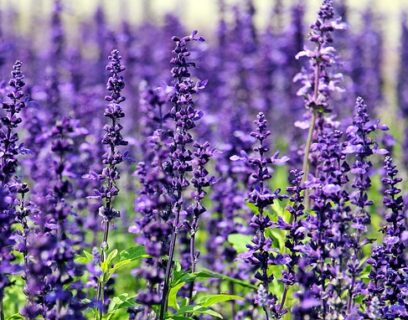 7 MIN
13 Sep
Lavender Cuttings: a step-by-step guide
7 MIN
13 Sep
Lavender Cuttings: a step-by-step guide
 11 MIN
10 Sep
Create Your Low-Maintenance Garden – Tips and Ideas
11 MIN
10 Sep
Create Your Low-Maintenance Garden – Tips and Ideas
 Scarifying Kit
All products after scarifying | Quickly restores the lawn after scarifying | Outsmart weeds quickly with the use of this kit
From: € 39.99
Scarifying Kit
All products after scarifying | Quickly restores the lawn after scarifying | Outsmart weeds quickly with the use of this kit
From: € 39.99
 Spring Lawn Care Kit
MOOWY’s choice for the spring | Quick recovery of your lawn after winter | A strong lawn prevents weeds
From: € 25.99
Spring Lawn Care Kit
MOOWY’s choice for the spring | Quick recovery of your lawn after winter | A strong lawn prevents weeds
From: € 25.99
 Long Lasting Lawn Fertiliser
Effective for 90 days | See results in 14 days! | Suitable for all types of grass and soil
From: € 13.99
Long Lasting Lawn Fertiliser
Effective for 90 days | See results in 14 days! | Suitable for all types of grass and soil
From: € 13.99
Do you want a lawn calendar?
🌱 All important maintenance moments for your lawn during the year. Leave your email and we will send you the lawn calendar for free.
Enter your email
Receive the lawn calendar in the mail
Enjoy a green lawn all year round!



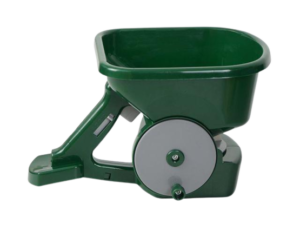

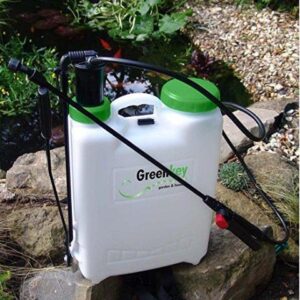

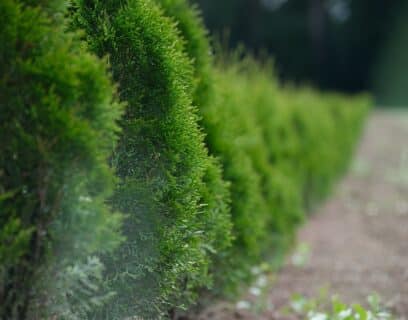






Comments (0)
There are no comments yet. Well then, what are you waiting for to
Be the first to write your comment!inaugurate this pretty page?
Do you have some comments?